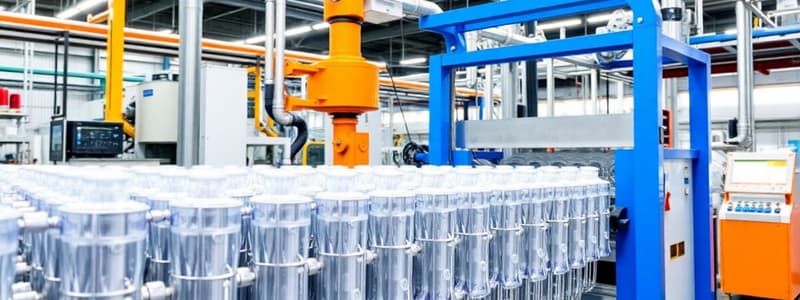Podcast
Questions and Answers
Which method is used to transform powders and granules into finished products?
Which method is used to transform powders and granules into finished products?
- Sintering
- Vacuum forming
- 3D printing
- Extrusion or injection (correct)
What forms do polymers exist in that are essential for materials engineering?
What forms do polymers exist in that are essential for materials engineering?
- Gases, liquids, and powders
- Solids, liquids, and aerosols
- Liquids, powders, and granules (correct)
- Foams, solids, and gels
What is traditionally the first step in processing thermoplastics?
What is traditionally the first step in processing thermoplastics?
- Cooling the material
- Crushing for recycling
- Heating the material (correct)
- Shaping the product
What is the purpose of the cooling system in thermoplastic processing?
What is the purpose of the cooling system in thermoplastic processing?
Which type of polymer can be reprocessed after initial shaping?
Which type of polymer can be reprocessed after initial shaping?
What type of energy can facilitate the transition of thermoplastic materials?
What type of energy can facilitate the transition of thermoplastic materials?
What processing method is commonly associated with shaping thermoplastics?
What processing method is commonly associated with shaping thermoplastics?
Which characteristic does NOT typically influence the choice of processing method for polymers?
Which characteristic does NOT typically influence the choice of processing method for polymers?
What is the primary purpose of technological modifiers in polymers?
What is the primary purpose of technological modifiers in polymers?
Which of the following is an example of a specific modifier used in polymer formulation?
Which of the following is an example of a specific modifier used in polymer formulation?
What role do thermal stabilizers play in the context of specific modifiers for polymers?
What role do thermal stabilizers play in the context of specific modifiers for polymers?
How does the use of technological modifiers reflect advancements in materials technology?
How does the use of technological modifiers reflect advancements in materials technology?
In what way do specific modifiers contribute to the performance of industrial materials?
In what way do specific modifiers contribute to the performance of industrial materials?
Which additive would likely be used to improve the overall blend quality in a polymer mixture?
Which additive would likely be used to improve the overall blend quality in a polymer mixture?
What is a key benefit of incorporating specific modifiers into polymer formulations?
What is a key benefit of incorporating specific modifiers into polymer formulations?
Which type of component could NOT be classified as a technological modifier?
Which type of component could NOT be classified as a technological modifier?
What is one of the basic components in thermosets processing?
What is one of the basic components in thermosets processing?
Which factor triggers the beginning of the chemical reaction in thermosets processing?
Which factor triggers the beginning of the chemical reaction in thermosets processing?
What happens to the object once the thermoset reaction is complete?
What happens to the object once the thermoset reaction is complete?
Which of the following is an example of an additive used in polymer formulation?
Which of the following is an example of an additive used in polymer formulation?
What is the primary role of stabilizers in polymer formulation?
What is the primary role of stabilizers in polymer formulation?
Which of the following modifiers can improve mechanical strength in polymers?
Which of the following modifiers can improve mechanical strength in polymers?
What is the significance of additives in thermosets processing?
What is the significance of additives in thermosets processing?
How can the flexibility of a polymer be adjusted?
How can the flexibility of a polymer be adjusted?
Flashcards
Thermoset processing
Thermoset processing
A process in which a material undergoes a permanent chemical change through the formation of cross-links between polymer chains, resulting in a solid, rigid, and heat-resistant material.
Catalyst
Catalyst
A substance that speeds up a chemical reaction without being consumed in the process, essential in thermoset processing to initiate the cross-linking reaction.
Initiator
Initiator
A substance that starts a chemical reaction, often used in thermoset processing to induce the formation of cross-links.
Shaping
Shaping
Signup and view all the flashcards
Curing
Curing
Signup and view all the flashcards
Additives
Additives
Signup and view all the flashcards
Modifiers
Modifiers
Signup and view all the flashcards
Polymer formulation
Polymer formulation
Signup and view all the flashcards
Thermoplastics
Thermoplastics
Signup and view all the flashcards
Thermoplastics Processing
Thermoplastics Processing
Signup and view all the flashcards
Molten State
Molten State
Signup and view all the flashcards
Mold
Mold
Signup and view all the flashcards
Molding
Molding
Signup and view all the flashcards
Cooling
Cooling
Signup and view all the flashcards
Reprocessing
Reprocessing
Signup and view all the flashcards
Recycling
Recycling
Signup and view all the flashcards
Technological Modifiers
Technological Modifiers
Signup and view all the flashcards
Catalysts in polymers
Catalysts in polymers
Signup and view all the flashcards
Surface Modification Agents
Surface Modification Agents
Signup and view all the flashcards
Dispersing Agents in Polymers
Dispersing Agents in Polymers
Signup and view all the flashcards
Inhibitors in Polymers
Inhibitors in Polymers
Signup and view all the flashcards
Specific Modifiers
Specific Modifiers
Signup and view all the flashcards
Thermal Stabilizers
Thermal Stabilizers
Signup and view all the flashcards
Reinforcement Agents
Reinforcement Agents
Signup and view all the flashcards
Study Notes
Chapter 1 Introduction
- Polymers exist in various forms (liquids, powders, granules) and are essential materials in materials engineering.
- Processing polymers is crucial in creating finished products.
- Liquid polymers can be molded to create complex items with specific characteristics.
- Powders and granules allow for versatility through extrusion or injection molding.
- The choice of processing method depends on the desired product attributes, manufacturing limitations, and application needs.
- Polymer transformation combines technical skill and creativity to address diverse demands of modern society.
I.1. Thermoplastics Processing
- Processing thermoplastics begins with various options: powder/granules, semi-finished products (plates, sheets, films), or thermoplastic paste.
- Heating or external energy (friction) transforms the material from solid to plastic/molten state.
- Mold or die shapes the material.
- Cooling solidifies the material into the desired form.
- Processed objects can be reprocessed (e.g. plates, sheets, films) or recycled (crushed).
I.1.2. Thermosets Processing
- Thermosets are made from one or more liquids, mixed with pastes or powders/granules.
- Chemical reaction is triggered by a catalyst/initiator (often by mixing products or supplied energy - usually heat).
- Shaping occurs before, during, or after reaction initiation (molding, injection, layering).
- Objects are demolded when the reaction is complete (typically at 90-100°C).
- Thermoset objects can't be recycled after curing.
I.2. Polymer Formulation
- Polymers often require modification to meet specific application needs.
- Additives (e.g., stabilizers, antioxidants, flame retardants) improve properties like thermal stability, weather resistance, and fire safety.
- Modifiers (e.g., plasticizers, fiber, mineral fillers) adjust flexibility, mechanical strength, etc.
- Polymer formulation is a systematic approach to fine-tune properties of the materials for specific applications.
Studying That Suits You
Use AI to generate personalized quizzes and flashcards to suit your learning preferences.




